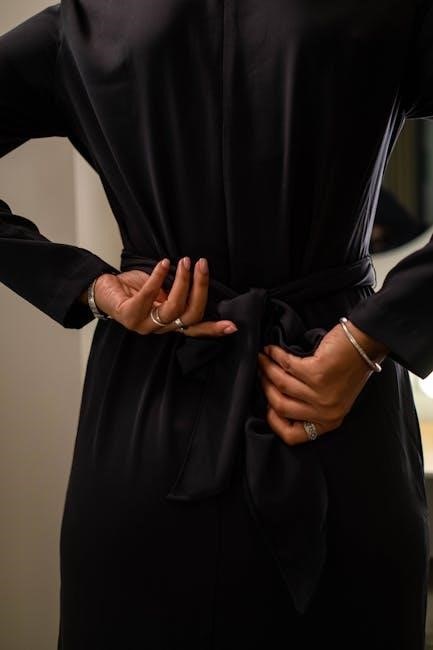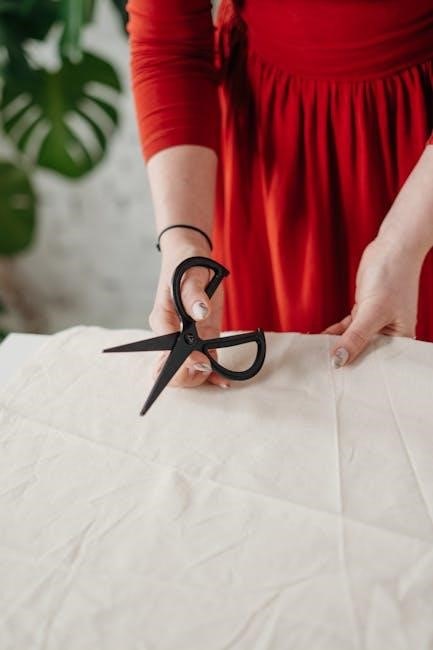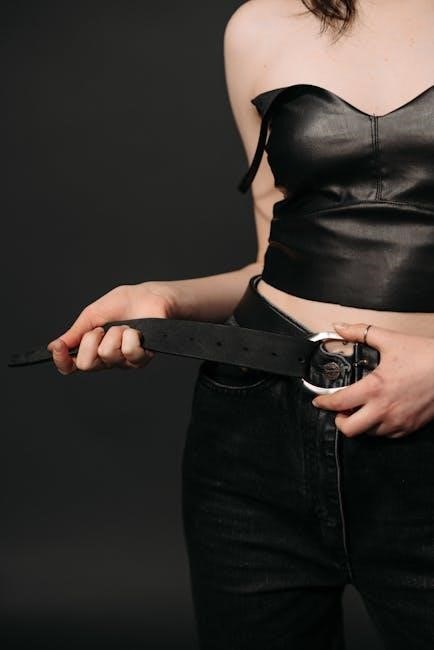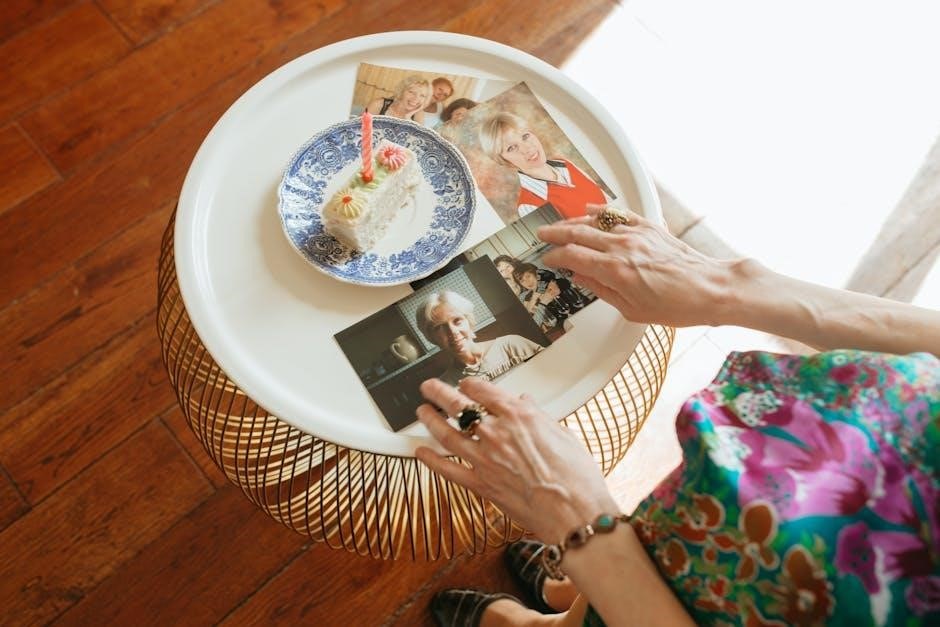Mastering one-handed dressing techniques empowers individuals to maintain independence and confidence. These strategies focus on simplified methods, adaptive tools, and practical tips to manage daily dressing challenges safely and effectively, promoting self-reliance and dignity through practice and patience.

Pre-Dressing Tips and Preparation
Preparation is key for one-handed dressing. Always start by dressing the affected arm first, use a pillow for support, and choose elasticated garments. Organizing clothes in advance ensures a smoother process.
Organizing Clothing
Organizing clothing is essential for one-handed dressing. Place garments face-down on a flat surface to simplify handling. Gather all necessary items beforehand to avoid multiple trips. Use a chair or table for support while dressing. Keep socks and underwear in easy-to-reach locations, such as a low drawer or basket. Consider using a dresser with large knobs or handles for easier access. Separate clothes into categories (e.g., tops, bottoms) to streamline the process. Fold or hang items in a way that minimizes tangled fabric. Elasticated waistbands and loose-fitting clothes are ideal for one-handed dressing. Ensure shoes are pre-laced or use slip-ons to save time. By organizing clothing thoughtfully, you can reduce frustration and make the dressing process more efficient and manageable.
Using a Pillow for Support
Using a pillow for support is a practical strategy in one-handed dressing. Place a pillow on your lap to create a stable surface for your affected arm or garment; This helps maintain balance and reduces strain. Rest your arm on the pillow while dressing to free your stronger hand for handling clothing. The pillow provides a soft, cushioned base, making it easier to maneuver garments such as shirts or jumpers. It also prevents the arm from slipping or moving involuntarily, allowing for better control. Position the pillow at a comfortable height to align with your body, ensuring ease of access. This technique minimizes the risk of dropping items and simplifies the process of sliding your arm into sleeves or openings. By incorporating a pillow into your dressing routine, you can enhance stability and efficiency, making one-handed dressing more manageable and less frustrating.

Upper Body Dressing Techniques
Mastering upper body dressing with one hand involves strategic techniques like placing garments on a pillow for support and using the stronger arm to guide sleeves. This method ensures ease and stability while dressing.
Putting on a Shirt
Putting on a shirt with one hand requires careful coordination and the use of adaptive techniques. Start by placing the shirt on a pillow or flat surface, with the front side facing down. Identify the armholes and neckline to orient the garment correctly. Slide your affected arm into the nearest sleeve first, resting it on the pillow for support. Use your stronger arm to guide the other sleeve over your shoulder, ensuring the shirt aligns properly; Gently pull the shirt up and over your shoulders, smoothing it into place. If the shirt has buttons, secure them using one-handed techniques or adaptive tools. Practice this method to build confidence and efficiency. Using loose-fitting fabrics can make the process easier, as they require less manipulation. This technique emphasizes independence and comfort, allowing individuals to dress safely without assistance.
Donning a Jumper
Donning a jumper with one hand involves strategic placement and careful maneuvering. Place the jumper front-down on your lap or a pillow, ensuring the neckline faces away from you. Use your stronger arm to hold the jumper in place while guiding your weaker arm through the sleeve. If needed, use your teeth to assist with pulling the fabric over your shoulder. Once the weaker arm is in, use your stronger arm to pull the jumper over your head or the other shoulder. For pullover jumpers, consider using a piece of adaptive equipment like a dressing stick to help guide the garment. Elasticated or loose-fitting jumpers are ideal as they require less effort to put on. Practice this technique to improve speed and comfort. This method ensures independence while maintaining balance and reducing strain during the dressing process.
Lower Body Dressing Techniques
Mastering lower body dressing with one hand involves using a pillow for support and opting for elasticated pants or skirts. Sit down to reduce strain and improve balance while dressing.
Putting on Pants
Putting on pants with one hand requires careful planning and balance. Begin by sitting down and placing the pants on your lap with the waistband facing you. Use your stronger hand to hold the pants while slipping your legs into them one at a time. For easier maneuvering, choose pants with elastic waistbands or loose-fitting designs. To pull them up, use your weaker hand to stabilize the pants while your stronger hand tugs them upward. If balance is an issue, consider using a pillow or chair for support. Ensure the pants are properly aligned before standing to adjust them further. Adaptive tools, such as dressing sticks, can also assist in pulling pants up without strain. Practice this technique to build confidence and efficiency in managing lower body dressing independently.
Mastering Sock Donning
Donning socks with one hand can be challenging but manageable with the right techniques; Begin by selecting socks made of lightweight, stretchy material, as they are easier to handle. Sit comfortably and prop your foot on the opposite leg, a low stool, or chair for stability. Use your stronger hand to spread the sock open with your fingers, ensuring the top elastic is easily accessible. Slide the sock over your foot, starting from the toes and gently pulling it up. To facilitate this, consider using adaptive tools like a sock aid, which allows you to guide the sock onto your foot without bending. If balance is an issue, practice while seated or use a support cushion. Elasticated socks are particularly recommended as they require less effort to put on. Regular practice and the use of assistive devices can significantly simplify this process, enhancing independence and efficiency in daily dressing routines.

Managing Fasteners
Mastering buttons and zippers with one hand requires precision and practice. Use adaptive tools like button hooks or zipper pulls to simplify tasks. Start with larger buttons and practice consistently to build dexterity and confidence in handling fasteners independently.

Buttons and Zippers
Managing buttons and zippers with one hand requires strategic techniques and tools. Adaptive devices like button hooks and zipper pulls can provide better grip and leverage. Start with larger buttons to build confidence, then progress to smaller ones. Choose clothing with magnetic or elastic closures for simplicity. Use the weaker hand to stabilize garments while the stronger hand handles fasteners. Practice consistently to enhance dexterity and coordination. Consider consulting occupational therapists for recommended tools and techniques. Maintain balance by dressing in a stable position, using a chair if needed. Patience and the right resources are key to mastering these skills effectively.
Using Adaptive Equipment
Adaptive equipment is essential for simplifying one-handed dressing. Tools like button hooks, zipper pulls, and dressing sticks can provide extra grip and leverage. Reachers are useful for fetching items out of reach. Consider clothing with magnetic or touch-fasten closures for easier use. Elastic waistbands and slip-on shoes reduce strain. A long-handled shoehorn aids in putting on shoes without bending. Adaptive utensils like sock aids or stocking donnors make lower body dressing manageable. These tools enhance independence and reduce frustration. They are especially beneficial for individuals with limited dexterity or strength. Occupational therapists can recommend specific devices tailored to individual needs. Incorporating these tools into daily routines fosters confidence and efficiency in dressing tasks. They are widely available through medical supply stores or online retailers, making them accessible for everyone.
Additional Dressing Strategies
Utilize the weaker hand to assist with tasks like stabilizing garments or holding items in place. Choose clothing with features like elastic waistbands or magnetic closures for ease. Prioritize balance and practice techniques to enhance coordination and independence.

Role of the Weaker Hand
The weaker hand plays a crucial role in one-handed dressing by providing stability and assistance. It can help stabilize clothing, hold items in place, or guide garments during the dressing process. For example, the weaker hand can steady a shirt while the stronger hand navigates the armholes or secure pants waistband for easier fastening. This support enables better coordination and balance, reducing the risk of dropping items or losing patience. Additionally, the weaker hand can assist in positioning garments correctly, such as aligning buttons or zippers within reach. While it may not perform the primary actions, its role is vital in making dressing safer and more efficient. Over time, practice strengthens the weaker hand’s ability to contribute, enhancing overall independence in daily activities. By incorporating the weaker hand strategically, individuals can master dressing tasks with greater ease and confidence.

Choosing the Right Clothes

Selecting the right clothing is essential for mastering one-handed dressing techniques. Opt for garments with elasticated waistbands, loose-fitting designs, and magnetic or easy-to-grasp fasteners, which simplify the process. Clothes made from stretchy fabrics like Lycra or elastane are ideal, as they provide flexibility and ease of movement. Avoid tight-fitting items or those with complex fasteners like small buttons or laces, as they can be challenging to manage. Consider adaptive clothing designed for individuals with limited dexterity, featuring innovations such as magnetic buttons, easy-slide zippers, or pull-on designs. Choosing the right clothes not only makes dressing easier but also enhances confidence and independence. Additionally, prioritize clothing with enlarged neck or arm openings to reduce strain and effort. By combining practicality with personal style, individuals can create a wardrobe that supports their needs while maintaining comfort and dignity.

Overcoming Common Challenges
Overcoming common challenges in one-handed dressing requires patience, balance, and strategic use of the weaker hand. Practice step-by-step methods, use adaptive techniques, and stay calm to build confidence and mastery.
Difficulty with Specific Garments

Certain garments, like bras or zippers, can present unique challenges for individuals dressing with one hand. Bras, for instance, may require creative strategies, such as fastening them in front and then rotating them into place. Zippers on jackets or pants can be tricky, but using the mouth or adaptive tools can simplify the process. Socks often pose difficulty, but using light elastic styles and propping the foot on a stool or opposite leg can aid in donning them. Additionally, garments with tight neck or arm openings may need to be stretched or adjusted to accommodate one-handed dressing. Adaptive equipment, such as sock aids or button hooks, can significantly ease these struggles. Patience and practice are key to mastering these specific challenges, as each garment may require a tailored approach to ensure independence and confidence in dressing.
Maintaining Balance
Maintaining balance is crucial while dressing with one hand, as it ensures safety and prevents accidents. Using a sturdy chair or non-slip mat can provide stability, especially when bending or reaching. Breaking tasks into smaller steps allows for better control and reduces the risk of losing balance. The weaker hand can assist by holding onto a surface or stabilizing the body. Opting for loose, elasticated clothing minimizes the need for complex movements. When dressing the lower body, propping the foot on a low stool or opposite leg can help maintain equilibrium. Adaptive tools, such as reachers, can assist in retrieving items without overreaching. Practicing these techniques in a safe environment builds confidence and reduces the likelihood of balance-related challenges. Over time, these strategies become second nature, enabling individuals to dress independently with greater ease and stability.
Resources and Further Reading
Explore PDF guides and online resources for detailed one-handed dressing techniques. Websites offer step-by-step instructions, adaptive tool recommendations, and practical tips to enhance independence and confidence in daily dressing routines.
Recommended Tools
Utilizing the right tools can significantly ease the process of one-handed dressing. A sock aid is a popular device that helps pull socks onto the feet without bending. Dressing sticks are essential for handling zippers, buttons, and pulling up garments. Adaptive utensils like button hooks simplify fastening tasks, while elastic laces make shoe-tying easier. Additionally, long-handled reachers can assist in retrieving clothing from the floor or high places. Using these tools promotes independence and reduces strain. Many of these aids are available through occupational therapy resources or online catalogs. Incorporating them into your routine can enhance efficiency and confidence in managing daily dressing challenges effectively. These tools are designed to accommodate various needs, ensuring that individuals can dress safely and comfortably with minimal effort.
Accessing PDF Guides
Accessing PDF guides on one-handed dressing techniques provides comprehensive step-by-step instructions and visual aids. These resources are often created by occupational therapists and healthcare professionals, ensuring practical and evidence-based advice. Many guides are available for free or purchase through official websites, online repositories, or therapy centers. Key sources include Therapy Skill Builders and Stroke Rehabilitation manuals. These PDFs detail methods for dressing the upper and lower body, managing fasteners, and using adaptive equipment. They also offer tips for organizing clothing and maintaining balance. To find reliable guides, search terms like “one-handed dressing techniques PDF” or “occupational therapy dressing strategies” can be useful. Always ensure guides are from credible sources to guarantee accurate and safe instructions. These resources are invaluable for individuals seeking to master independent dressing with one hand, offering clear, actionable strategies for daily living.

